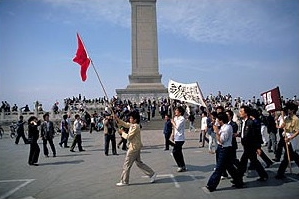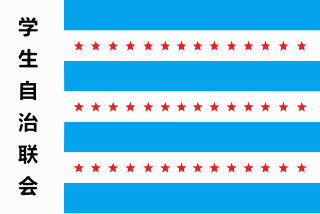Related Research Articles

The Tiananmen Square protests, known in Chinese as the June Fourth Incident, were student-led demonstrations held in Tiananmen Square, Beijing during 1989. In what is known as the Tiananmen Square Massacre, or in Chinese the June Fourth Clearing or June Fourth Massacre, troops armed with assault rifles and accompanied by tanks fired at the demonstrators and those trying to block the military's advance into Tiananmen Square. The protests started on 15 April and were forcibly suppressed on 4 June when the government declared martial law and sent the People's Liberation Army to occupy parts of central Beijing. Estimates of the death toll vary from several hundred to several thousand, with thousands more wounded. The popular national movement inspired by the Beijing protests is sometimes called the '89 Democracy Movement or the Tiananmen Square Incident.

Chai Ling is a Chinese psychologist who was one of the student leaders in the Tiananmen Square protests of 1989. She is the founder of All Girls Allowed, an organization dedicated to ending China's one-child policy, and the founder and president of Jenzabar, an enterprise resource planning software firm for educational institutions.
Hu Qili is a former high-ranking politician of the Chinese Communist Party (CCP). He was a member of the CCP Politburo Standing Committee and a member of its Secretariat between 1987 and 1989. In 1989, he was purged because of his sympathy toward the students of the 1989 Tiananmen Square protests and his support for General Secretary Zhao Ziyang. However, he was able to get back into politics in 1991. In 2001, he was named chairman of the Soong Ching-ling Foundation.
Chen Xitong was a member of the Politburo of the Chinese Communist Party and the Mayor of Beijing until he was removed from office on charges of corruption in 1995.

Almost a Revolution is an autobiography by Shen Tong (沈彤), one of the student leaders during the 1989 Tiananmen Square protests and massacre in Beijing, China, written with former The Washington Post writer Marianne Yen.
Moving the Mountain is a 1994 feature documentary directed by Michael Apted and produced by Trudie Styler, with cinematography by Maryse Alberti and music by Liu Sola.
The Beijing Workers' Autonomous Federation (BWAF), or Beijing Workers’ Autonomous Union was the primary Chinese workers' organization calling for political change during the Tiananmen Square protests of 1989. The group was formed in the wake of mourning activities for former General Secretary of the Chinese Communist Party Hu Yaobang in April 1989. The BWAF denounced political corruption, presenting itself as an independent union capable of "supervising the Communist Party," unlike the Party-controlled All-China Federation of Trade Unions (ACFTU).
The April 26 Editorial was a front-page article published in People's Daily on April 26, 1989, during the Tiananmen Square protests. The editorial effectively defined the student movement as a destabilizing anti-party revolt that should be resolutely opposed at all levels of society. As the first authoritative document from the top leadership on the growing movement, it was widely interpreted as having communicated the party's position of "no-tolerance" to student protesters and their sympathizers.

Feng Congde is a Chinese dissident and Republic of China Restoration activist. He came into prominence during the Tiananmen Square protests of 1989 as a student leader from Peking University, which placed him onto the Chinese government's 21 Most Wanted list. He spent 10 months hiding in various locations in mainland China, until he was smuggled out to Hong Kong on a shipping vessel.

The Beijing Students' Autonomous Federation was a self-governing student organization, representing multiple Beijing universities, and acting as the student protesters' principal decision-making body during the 1989 Tiananmen Square protests. Student protesters founded the Federation in opposition to the official, government-supported student organizations, which they believed were undemocratic. Although the Federation made several demands of the government during the protests and organized multiple demonstrations in the Square, its primary focus was to obtain government recognition as a legitimate organization. By seeking this recognition, the Federation directly challenged the Chinese Communist Party's authority. After failing to achieve direct dialogue with the government, the Federation lost support from student protesters, and its central leadership role within the Tiananmen Square protests.
Yan Mingfu is a retired Chinese politician. His first prominent role in government began in 1985, when he was made leader of the United Front Work Department for the Chinese Communist Party (CCP). He held the position until the CCP expelled him for inadequately following the party line in his dialogues with students during the 1989 Tiananmen Square protests. Yan returned to government work in 1991 when he became a vice minister of Civil Affairs.
A Heart for Freedom: The Remarkable Journey of A Young Dissident, Her Daring Escape, And Her Quest to Free China's Daughters is an autobiography by Chai Ling (柴玲), one of the student leaders in the Tiananmen Square protests of 1989 in Beijing, China. The book was published in 2011 by Tyndale House, a Christian press based in Illinois.
The April 27 demonstrations were massive student protest marches throughout major cities in China during the 1989 Tiananmen Square protests and massacre. The students were protesting in response to the April 26 Editorial published by the People's Daily the previous day. The editorial asserted that the student movement was anti-party and contributed to a sense of chaos and destabilization. The content of the editorial incited the largest student protest of the movement thus far in Beijing: 50,000–200,000 students marched through the streets of Beijing before finally breaking through police lines into Tiananmen Square.
Defend Tiananmen Square Headquarters was formed on May 24, 1989. The purpose of this organization was to create a strong leadership to lead the student movement.

A Tiananmen Journal: Republic on the Square by Feng Congde (封从德) was first published in May 2009 in Hong Kong. This book records the 1989 Tiananmen Square protests and massacre from April 15, 1989, to June 4, 1989, in detail. Author Feng Congde is one of the student leader in the protest and his day-by- day diary entries, record every activity during the protest including the start of student protests in Peking University, the activities of major student leaders, important events, and unexposed stories about student organizations and their complex decision making.
During the Tiananmen Square protests of 1989 in Beijing, China, students demanded a dialogue between Chinese government officials and student representatives. In total, three sessions of dialogue took place between the students and government representatives.
The catalyst for the birth of the Pro-Democracy Movement was the death of Hu Yaobang on April 15, 1989. Beginning in late April until June 3 large crowds gathered in Tiananmen Square. During this period a significant amount of money was donated to the student organizations, it was spent on providing food, water and other supplies required to sustain the many thousands of protesters who occupied the Square.
Many women participated in the Tiananmen Square Protests of 1989 for democratic reform in China. Lee Feigon states "women [during the Tiananmen Square Protests] were relegated for the most part to traditional support roles." Chai Ling and Wang Chaohua, however, were female student leaders taking part in leadership activities during the pro-democracy movement. Ranging from student leaders to intellectuals, many women contributed their opinions and leadership skills to the movement. Although women had substantial roles, they had different standpoints regarding the hunger strike movement on May 13.
During the 1989 Tiananmen Square protests and massacre student demonstrators created and distributed a large variety of propaganda. The first of these were memorial posters dedicated to Hu Yaobang, which were placed in Peking University following his death on Saturday April 15, 1989. On April 16th and 17th, pamphlets, leaflets and other forms of propaganda began to be distributed by university students both in Peking University and at Tiananmen Square where large congregations of students began to form in what became the beginning stages of the protest. These were used to communicate among the students as well as to spread their messages and demands to groups such as the Chinese government and foreign media. Other forms of propaganda would emerge as the protests continued, such as a hunger strike beginning on May 13 and visits from celebrities and intellectuals, as well as speeches and songs. All of these were used to promote the interests of the student protest movement.
The 1989 Tiananmen Square protests and massacre, commonly known in mainland China as the June Fourth Incident, were student-led demonstrations in Beijing in 1989. More broadly, it refers to the popular national movement inspired by the Beijing protests during that period, sometimes called the '89 Democracy Movement. The protests were forcibly suppressed after Chinese Premier Li Peng declared martial law. In what became known in the West as the Tiananmen Square Massacre, troops with assault rifles and tanks fired at the demonstrators trying to block the military's advance towards Tiananmen Square. The number of civilian deaths was internally estimated by the Chinese government to be near or above 10,000.
References
- ↑ Chai Ling. A Heart for Freedom (Tyndale Momentum, 2011), 134–135.
- 1 2 The Gate of Heavenly Peace. (1995, Brookline, MA: Long Bow Group, Inc, 1995.), VHS.
- ↑ Chai, 149
- ↑ Zhao, Dingxin The Power of Tiananmen (Chicago: The University of Chicago Press, 2001), 173.
- 1 2 Chai, 126.
- ↑ Chai, 121–122.
- ↑ Tan Weier, "媽媽我餓了,但我吃不下 絕食源起" People Will Not Forget, 2010 [ permanent dead link ]
- ↑ Lim, Louisa. The People's Republic of Amnesia. (New York: Oxford University Press, 2015), 67.
- 1 2 Lim, 67.
- ↑ Tan Weier, "媽媽我餓了,但我吃不下 絕食源起" People Will Not Forget, 2010, http://1989report.hkja.org.hk/site/portal/Site.aspx?id=A27-53 Archived 2016-04-23 at the Wayback Machine .
- ↑ Chai, 129.
- ↑ Li Lu, Moving the Mountain: My Life in China (London: Macmillan, 1990), 130–131.
- ↑ Chai, 132–133.
- ↑ Zhang Liang, The Tiananmen Papers, ed. Andrew J. Nathan and Perry Link (New York: Public Affairs, 2011), 153–156.
- ↑ Li, 133.
- ↑ The Gate of Heavenly Peace. (Long Bow Group, Inc, 1995.), VHS.
- ↑ Chai, 148–149.
- ↑ Cunningham, Philip J. Tiananmen Moon: Inside the Chinese Student Uprising of 1989. (Lanham, MD: Rowman & Littlefield Publishers, 2009). eBook Collection (EBSCOhost), 89.
- ↑ Zhang, 173.
- ↑ The Gate of Heavenly Peace. (1995, Brookline, MA: Long Bow Group, Inc, 1995.), VHS.
- ↑ Zhao, D, 173.
- ↑ Zhang, 164.
- ↑ Zhao, D, 171.
- ↑ Cox, Cindy, "Chronology of Events Related to the 1989 Tiananmen Square Incident", World Affairs 152 (Winter 1989-90), 129–134: https://www.jstor.org/stable/20672217.
- ↑ Zhang, 164–165, 202–203.
- ↑ Zhang, 176.
- ↑ Zhao Ziyang, Prisoner of State: The Secret Journal of Zhao Ziyang, ed. Bao Pu, Renee Chiang, and Adi Ignatius (New York: Simon & Schuster, 2009), 31.
- ↑ Lim, 68.
- ↑ "Hong Kong protest leader, Joshua Wong, ends hunger strike". BBC, December 6, 2014. (Accessed: March 29, 2016).